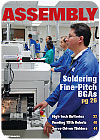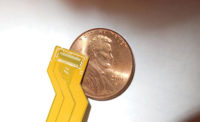

Well made solder-printing stencils are critical to creating high-quality BGA assemblies. The larger of the two stencils above is framed. The smaller stencil is non-framed.
These issues comprise one side of the assembly story. The other is that BGA-associated solder defects are often tricky to detect, due to shrinking BGA sizes and the fact that collapsed balls cannot be seen by the human eye, even with the help of a magnifying glass.

BGA packages employ hundreds of tiny solder balls on the bottom of the package to provide the leads necessary to connect today’s sophisticated integrated circuits.
The Way We Were
In the past, so-called J-gull packaging was used to create multiple leads on a single package. However with the increasing complexity of today’s circuitry, chipmakers have adopted BGAs to cut manufacturing costs and permit more functionality in smaller and smaller spaces. As the name implies, BGA packages use tiny balls, often 1,000 or more, which are soldered onto a PCB to make the necessary connections. BGAs are defined by the “pitch” of the balls, or the distance from the center of one ball to the center of the next. A package with a one-millimeter pitch is considered a standard BGA. Anything smaller is considered a micro-BGA. Micro-BGAs can have pitches of 0.6, 0.5, 0.4 and even 0.3 millimeter.BGAs are available with both plastic and ceramic bodies. Plastic BGAs are the most popular due to their lower cost, while ceramic BGAs are used for more demanding telecommunications, laptop and device-under-test equipment applications.
A third type of BGA is a metal-core BGA, which allows designers to add even more circuitry than is possible when employing plastic or ceramic bodies. With a metal-core BGA, additional mini-circuitry is placed inside the BGA package, complementing the regular balls and circuitry already there. This is done by placing a metal cover over the resident chip and using the space inside the metal core as a base for various capacitors and resistors.
Whatever the specific type of BGA, electronics contract manufacturers need to be extremely careful when determining the reflow profile, creating printing stencils and choosing a solder paste and flux. The goal is to create acceptable assemblies the first time around. Reworking a BGA with opens or shorts not only requires considerable precision and skill, but can damage the BGA and its adjoining circuitry.
With regard to flux, there are basically two kinds: water soluble and no-clean. No-clean flux is used when a circuit board can’t be washed with de-ionized water at the end of the assembly and reflow process due to the presence of crystals, LCDs or other moisture-sensitive components. Water-soluble flux is used on PCB’s that can be washed with de-ionized water at the end of assembly. Whatever the flux used, it’s important to remember that flux type will determine the activity level between the flux and solder paste.
During the inspection phase, powerful X-ray machines are essential to view the solder joints under a BGA package to ensure that correct “ball collapse” occurred during reflow. These high-end systems provide a 3D rendering of the otherwise hidden balls, facilitating effective quality control. Because the balls are so close to each other, X-ray technicians must be well trained to avoid misreading a view and erroneously drawing the conclusion that a solder defect exists where in reality there isn’t one.

Poor reflow, sloppy stencil printing and the use of an inappropriate flux can all result in open solder ball defects, as seen in the second solder ball from the left.
Solder Defects
With the advent of smaller and smaller BGA pitch sizes, several types of solder defects are emerging as problems for contract manufacturers. One of these is the open solder joint, also known as a non-collapsed ball, which results from insufficient heat during reflow. Another problem known as BGA intermittent connection, or BIC, affects all pitch sizes and is especially insidious because it is often highly elusive, costing OEMs thousands of dollars in lost engineering time and product launch delays.As the name implies, BICs fail only periodically. Because they are difficult to locate, BICs can produce a kind of domino effect by dispatching the mysterious, hard-to-track design problem into various OEM engineering groups and eventually into top management.
In addition to BICs and non-collapsed balls, engineers also need to beware of cracked BGA balls, shorts and opens. Like BICs and non-collapsed balls, these defects often result from the use of a flawed thermal profile for reflow.
A thermal profile describes the range of temperatures at which a PCB is heated during reflow as well as the amount of time the board spends at each temperature. When all the temperature zones of a thermal profile are correctly dialed in, the result is perfect reflow, which can be verified using a BGA X-ray.
A common industry mistake is to develop and apply one of three basic thermal profiles-one for small PCBs, another for medium-sized PCBs and a third for large PCBs-no matter what the assembly. Unfortunately, while this approach may appear to save time in the beginning, it can result in multiple problems further along, because it fails to take into account a board’s particular needs or the properties of a particular solder paste.
A number of factors are involved in determining the correct thermal profile. These include PCB layer count, the number of planes inside the board, the type of PCB material used, component types, component density, and PCB thickness as well as its length and width. Failure to provide adequate heat to ensure sufficient flux activity will prevent the balls from collapsing correctly. It is also critical that sufficient heat is applied to the BGA’s middle section so that all the package’s solder balls will collapse evenly.
With regard to component type, through-hole connections, or “vias,” and poorly defined stencil apertures can cause BICs if they are not accommodated for during the design process. Inexperienced designers often place vias next to BGA pads or around BGA peripheries without masking them correctly. This can hinder correct reflow because solder is sucked into the vias instead of being consumed by the BGA balls. Fortunately, these kinds of placement problems can be caught in the course of a design-for-manufacture (DFM) check during production planning-one of many reasons to be sure to have such a program in place. Otherwise, reflow becomes highly problematic and vias with solder paste traces can result in those highly evasive BGA intermittent connections.
With regard to basic temperature concerns, if the profile is not hot enough then “cold,” incompletely collapsed solder joints can result. If, on the other hand, the profile is too hot, the board will experience solder bridging, or shorts, not only between BGA balls, but also between the leads of the other fine-pitch surface mount components populating the board.
Bear in mind that even if it passes a functional test at the end of the assembly line, a marginal PCB may still fail in the field, which means the same expensive rework that results from a failed quality inspection. It should go without saying that using a thermal profile for a lead-free PCB on a standard eutectic board can have devastating effects because of the much higher temperatures involved, which can damage the board’s various components.

This technician is examining the height of solder paste deposition after stenciling, another critical factor in creating high-quality BGA assemblies.
Stencil Printing
In addition to correct reflow, correct stencil printing is critical is to a successful PCB assembly. Stencil thickness, aperture sizes and the use of frame or non-framed stencils all play a role in the accurate dispensing of solder paste onto the board.Solder paste, for example, has a tack life, which imposes a time limit between solder paste deposition and its reflow. Basically, after a few hours the solder paste dries up and won’t reflow correctly. Therefore, after dispensing, the boards must be promptly processed through the pick-and-place machine and reflow oven to avoid solder defects.
With regard to stencil thickness, the correct amount depends on the density of the components on the board. Unfortunately, there’s no logical, classroom or textbook formula for determining the correct stencil thickness for a particular assembly, and it is often a matter of experience to figure it out. Nonetheless, the correct thickness plays an important role in determining the amount of solder paste that will be dispensed on the surface mount pad, which, in turn, plays a role in avoiding bridges and cold solder joints.
Stencils with incorrect aperture sizes can also cause problems, so engineers need to be sure and perform a DFM check once the post-layout database has been converted to the “Gerber files” used to create the stencil aperture holes through decodes. Gerber files consist of combinations of lines all interconnected on an X-Y coordinate system. On occasion, software glitches will wrongly define either the coordinates or the aperture size, which will cause opens or shorts at Gerber levels. These glitches are hard to detect without performing a formal DFM check before the PCB production files are released to the fabrication house-yet another reason why an effective DFM program is critical to effective, efficient electronics manufacturing.
Too much paste can create shorts between fine-pitch BGA balls. Conversely, too little paste can result in insufficient wetting and cold solder joints. For this reason, it is important to balance the wetting to ensure sufficient flux is spread evenly across the entire surface of the PCB’s surface mount pads. Wetting balance is detected through the use of a force meter, which measures the solder as it wets up a component’s legs. This figure, in turn, allows engineers to determine wetting force across the PCB.
Note that with regard to stencil construction, non-framed stencils can be problematic because of the non-uniformity that can result form the lack of rigid framing. Non-uniformity, in turn, will cause uneven dispensing.
Also note that even after conducting all the DFM checks, a first-article test board is still crucial to minimizing stencil thickness defect problems during actual production. Pre- and post-reflow quality assurance inspections also allow a contract manufacturer to catch and correct these and any other discrepancies that may still exist at the end of the design process before ramping up actual production. Detecting problems like BGA component damage or components that are being tilted or twisted as a result of incorrect reflow temperatures well in advance will prevent major headaches and expense down the road.
During actual production, the use of advanced 3D solder paste inspection tools like paste-height inspection and automatic optical inspection (AOI) is critical to precise assembly. AOI checks for voids, opens, shorts, misplaced and wrong-value components on assembled boards, while paste height inspection is used after printing to measure the distance from the surface mount pad on the board to the top of the printed solder paste. During prototype runs, a good sampling size would be five to 10 boards. However, during larger production runs, sample sizes of 20 or 30 may be necessary.
